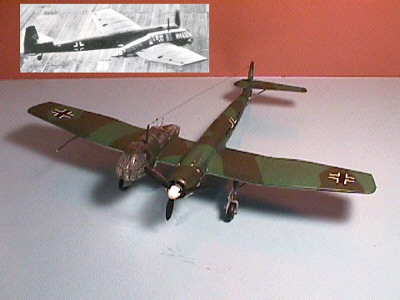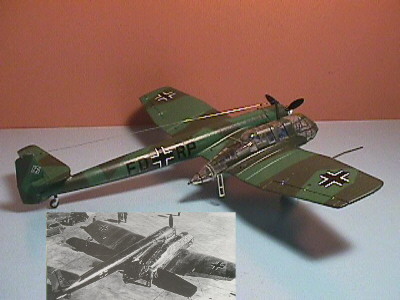Airfix 1/72 Blohm & Voss Bv 141 B
Manufacturer: Airfix - Pattern No. 394
Price: $2.89 (1969-71?- Price sticker still on box)
Media: Injection molded plastic
Decals: Yukkk! (did we actually put these on our models?)
Accuracy: Scale and appearance look good to me
Overall: C+
Review and Photos by Bob Swift
Another photo at bottom of review
In late Summer, 1996, we experienced a rare weather phenomenon for our hilly
area, a tornado. The track of this twister went directly through the self-storage
location where we rented a stall. Later when we were permitted to enter the
area and claim what remained of our goods, we found our stall with both walls
and roof gone; parts of the rear wall still intact and all our goods just
sitting there. The stalls on either side were completely gone, with their
contents. Amidst all the debris were the eight, or so large cartons which
held the many models I never quite got around to building. My Better Half
convinced me , long ago, that they should be there, safe and secure (out
of her way, also!). I'm not strongly religious, but there is no doubt that
this was a SIGN. Once our grandson rekindled interest in modeling again,
I opened the 'German' box, and sitting on top was the Bv 141 in 1/72 scale.
This and the Monogram kit of the Do 335 were the first two kits I started,
to see if any skills remained from 25+ years ago.
 This has to be one of the strangest looking aircraft to appear during WWII;
it was designed in 1937 by Richard Vogt who had recently returned after many
years living, working and teaching in Japan. It was a private venture in
response to a specification issued by the RLM for a light recon and bombing
aircraft for army cooperation duties. Official thinking on this spec envisioned
a multi-engined aircraft (ala the Fw 189) to achieve the desired all around
visibility required in this type of aircraft; since the spec did not define
this point, Vogt's solution was a single engine and asymmetric layout of
the various parts to achieve the same result. Needless to say, the design
was not warmly received.
This has to be one of the strangest looking aircraft to appear during WWII;
it was designed in 1937 by Richard Vogt who had recently returned after many
years living, working and teaching in Japan. It was a private venture in
response to a specification issued by the RLM for a light recon and bombing
aircraft for army cooperation duties. Official thinking on this spec envisioned
a multi-engined aircraft (ala the Fw 189) to achieve the desired all around
visibility required in this type of aircraft; since the spec did not define
this point, Vogt's solution was a single engine and asymmetric layout of
the various parts to achieve the same result. Needless to say, the design
was not warmly received.
Then as now, politics were in vogue and somehow Blohm & Voss managed
to show the aircraft to the top man, Ernst Udedt and even convinced him to
take it for a test drive. Evidently he was impressed with the performance
and docile handling and ordered a batch of four for further development.
The original cabin design was changed to that used on the Fw 189, and
anticipating the underpowered complaint regarding the BMW 132 engine, Vogt
had opted to re-engine with the BMW 801. This, and many other changes (asymmetric
tailplane, etc.) led to the 'B' model. Too bad more attention wasn't paid
to the more serious shortcomings of the poor hydraulic system, because with
the demise of Udedt this was one of a number of points seized upon to terminate
development of this type by officials who didn't like the bizarre aircraft
from day one. Not many Bv 141's were built; some thought was given to forming
an operational unit using the aircraft, but the type never reached that status.
The kit was molded in pale blue plastic with sixty, or so relatively flash
free parts. Typical of moldings from this period, surface detail, rivets,
etc. are raised. About this time Airfix was beginning to make efforts in
reducing rivet detail from the huge bumps of previous offerings to something
more reasonable; while still far from 'scale', the little bumps are not that
objectionable. Unlike many contemporary modelers from that time period, we
usually left the 'bumps' on, unless they were really grossly out of proportion.
So, we left them on this time as well.
Instruction sheet is more graphic than verbal, but is adequate to guide the
builder along. Wheel wells are not boxed in and doors are a bit too thick;
correctable if you wish to invest the effort. Construction is straightforward
and part fit is very good for a kit of this era; exception is the Airfix
trademark poor fit at the wing roots/fuselage joints; lots of opportunity
to perfect your filling /sanding technique. Cockpit detail is mostly
non-existent; we stuffed some detail in because of all the clear glazing,
but in this scale you can't do too much. The crew figures are little plastic
blobs and not worth the effort; the interior width was only 3.5 feet in the
real thing, anyway.
Canopies were extremely thick, not very clear, and due to the Airfix practice
of just tossing them in the box along with everything else, they were badly
scratched and gouged. Not being up to speed on techniques like dipping in
Future floor finish, we did it the hard way with jewelers rouge, buffing
wheel and Dremel set to the lowest possible speed. Great care taken to avoid
creating friction to the point of melting the plastic. They cleaned up to
an acceptable level and were used as is. Lots of flat panels and frames to
consider. Our method of painting canopy framing is unique and scary; so,
we'll just state that it works pretty well.
 The tailplane support is a little too long and needs to be trimmed after
careful measurement. Aligning and order of placement of all the wing segments
relative to the fuselage and cockpit requires some care and planning; fortunately
the large amount of wing dihedral is already molded in; just have to make
sure both sides match.
The tailplane support is a little too long and needs to be trimmed after
careful measurement. Aligning and order of placement of all the wing segments
relative to the fuselage and cockpit requires some care and planning; fortunately
the large amount of wing dihedral is already molded in; just have to make
sure both sides match.
Markings on this model are fictitious (poetic license); the kit decals were
unusable even back in the late sixties; four to five times thicker than today's
offerings, opaque in clear areas, poorly drawn with straight lines that squiggle
and after 25 years they disintegrate with the slightest touch of moisture.
Dug out some Microscale sheets from back then that could provide useable
elements, but they fell apart as well. A trip to an area hobby shop for new
decal sheets was rewarding. The proprietor introduced us to Microscale Liquid
Decal Film rather than trying to sell us all new sheets. The material works
as advertised; all old elements were salvaged and used. Support your local
guy as much as possible; it is good business.
Finished colors are a guestimate , but they look good; the whole is sealed
with Poly-S satin finish. Certainly not a model up to the high tech jewels
being turned out today, nor as accurate, I'm sure, but it is good to visit
the past now and then; that's the essence of modeling this area of history
anyway, visiting the past. Gives you a much better perspective and appreciation
of what's available today. Happy modeling.
Copyright ModelingMadness.com.
Back to Main Page
Back to Reviews Page
 This has to be one of the strangest looking aircraft to appear during WWII;
it was designed in 1937 by Richard Vogt who had recently returned after many
years living, working and teaching in Japan. It was a private venture in
response to a specification issued by the RLM for a light recon and bombing
aircraft for army cooperation duties. Official thinking on this spec envisioned
a multi-engined aircraft (ala the Fw 189) to achieve the desired all around
visibility required in this type of aircraft; since the spec did not define
this point, Vogt's solution was a single engine and asymmetric layout of
the various parts to achieve the same result. Needless to say, the design
was not warmly received.
This has to be one of the strangest looking aircraft to appear during WWII;
it was designed in 1937 by Richard Vogt who had recently returned after many
years living, working and teaching in Japan. It was a private venture in
response to a specification issued by the RLM for a light recon and bombing
aircraft for army cooperation duties. Official thinking on this spec envisioned
a multi-engined aircraft (ala the Fw 189) to achieve the desired all around
visibility required in this type of aircraft; since the spec did not define
this point, Vogt's solution was a single engine and asymmetric layout of
the various parts to achieve the same result. Needless to say, the design
was not warmly received.
 The tailplane support is a little too long and needs to be trimmed after
careful measurement. Aligning and order of placement of all the wing segments
relative to the fuselage and cockpit requires some care and planning; fortunately
the large amount of wing dihedral is already molded in; just have to make
sure both sides match.
The tailplane support is a little too long and needs to be trimmed after
careful measurement. Aligning and order of placement of all the wing segments
relative to the fuselage and cockpit requires some care and planning; fortunately
the large amount of wing dihedral is already molded in; just have to make
sure both sides match.